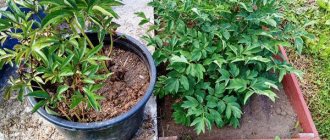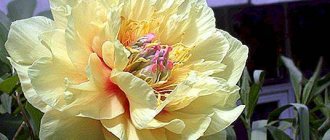Blooming peonies is an amazingly beautiful sight, especially if the flowerbed consists only of these flowers. The decorative period lasts quite a long time, and the large, lush heads are a real decoration of the landscape. In addition, the plants have a wonderful aroma.
It is known that the flowering period of peonies largely depends on the variety and variety of the flower, as well as on the growing conditions and care. We will find out in the article when peonies bloom, how long this process lasts, and under what conditions it takes the longest.
What factors determine the timing and splendor of peony flowering?
The first flowering of peonies can occur in different months - much depends on the timing of planting and the type of flower. Early varieties begin to bloom in May, the process lasts on average 3 weeks. Immediately after the early ones, mid-flowering varieties, interspecific hybrids, bloom. Late peonies in late June and early July delight with colorful buds until the beginning of August.
Important! If you take into account the flowering times of different varieties of peonies, you can always create a beautiful, lush, fragrant flowerbed.
Peonies bloom from May to August - it all depends on the variety and region
When do the most common species bloom in our latitudes?
Peony varieties are selected depending on the type of soil and weather conditions. You cannot plant a plant in a pot, since the substrate in it will be depleted faster, and therefore you should carefully look for options for your garden. Considering the unpretentiousness of the plant, this is not difficult.
However, when do the most common varieties begin to bloom? Information about this is detailed in the table:
| Name | Beginning of flowering |
| Maryin root | May 15-20 |
| Delaway | May 23-24 |
| Milky-flowered | June 10-15 |
| Reverse oval | June 1-5 |
| Drug | June 10-15 |
| Rock | May 25-29 |
What time do peonies bloom?
The crops grow in early spring, the growth period of the stems is about 40 days. Flowering time occurs 45 days from the start of the growth process. On average, buds remain attractive for up to 2 weeks, each flower for no more than 7 days.
Important! In hot weather, flowering is brighter, but quite fast.
Hybrid varieties will be the most unpretentious to grow
Super early
Super early varieties of peonies include American hybrids. They pleasantly surprise with a luxurious crown and terry buds. The most popular variety is Velma. Peonies bloom after planting for a month or two, this is approximately the end of May.
The delicate petals of super early hybrids bloom before anyone else
Early
At the beginning of June, the Pearl Placer blooms. Peony produces a large number of shoots that grow up to 90 cm in height. The petals are pearlescent at first, then become rich pink. After the Pearl Placer, the hybrid America blooms. The buds last for 3 weeks.
Early peonies are the main flowers of June
Medium flowering peonies
After the early varieties, the mid-flowering varieties take over the baton. Here the period shifts to June 15, flowering lasts on average until the 30th. Popular varieties are crimson Mirage, snow-white Duchess, spherical “daisies” Miss America.
Medium varieties bloom in the second half of June, but in regions with cold climates the timing may move to July
When do late peonies bloom?
On late varieties, the inflorescences last until the end of July. The varieties delight with the original shape of flowers, long flowering, and unusual color. Popular types are spherical Anchatresses with terry petals, lilac buds John Peyton, spreading Arkady Gaidar, spherical terry Gladys Taylor.
Late varieties of peonies are especially luxurious and rich-looking.
Planting and caring for peonies
- Planting: late August or early September.
- Flowering: May.
- Lighting: bright sunlight in the first half of the day, then bright diffused light or light partial shade.
- Soil: slightly acidic loam.
- Watering: infrequent, but plentiful: 2-3 buckets of water for each adult bush.
- Feeding: the first feeding is carried out in early spring, and from the second week of May, peonies are treated with a solution of mineral or organic fertilizer every month, leaves at a time.
- Reproduction: root cuttings and seeds (rarely).
- Pests: bronze beetles, turf ants, root-knot nematodes.
- Diseases: gray rot, rust, brown spot, septoria, root rot, viral mosaic.
Read more about growing peonies below.
flower (lat. Paeonia) is a monotypic genus of herbaceous perennials, the only one in the Peony family. There are herbaceous types of peonies, tree peonies, and also types that combine the properties of both tree and herbaceous peonies - about forty species in total. In nature, peony flowers grow in the temperate and subtropical zones of North America and Eurasia. Cultural cultivation of peonies began in China during the Han era, more than two thousand years ago. The peony flower is named after the legendary healer Pean, who saved both gods and people from mortal wounds received in battles. In our gardens, we mainly grow herbaceous peony, highly valued by gardeners for the beautiful fragrant buds that decorate the flowerbed from May for a month and a half. Our story will be about these peonies.
Are there peonies that bloom in autumn?
In Russia, this is unlikely, largely due to certain crop requirements for growing conditions and the early onset of cold weather. In Japan, some varieties bloom even in September. If you want to create a beautiful flower bed in the autumn months, you need to realistically assess the climatic conditions, provide proper care, probably shelter, and rely on late hybrids. In any case, peonies bloom very rarely in the months after August.
Important! Some gardeners “play” with fertilizers to get beautiful autumn plantings.
It is problematic to achieve autumn flowering of peonies in the Russian climate.
Is it possible to replant a blooming peony?
It is possible to replant during flowering, but it is not advisable. During this period, the plant is already prepared to produce flower stalks: buds are formed, ready for flowering.
Flowering peony “Bowl of Beauty”
If such a situation arises urgently, then this must be done extremely carefully:
- Prepare the soil, add humus and fertilizing to it;
- Carry out thorough watering;
- Carefully move the plant with a large lump of earth to a new planting site;
- Replanting should only be done in cloudy or rainy weather;
- During rooting, carefully monitor its condition, constantly moistening the soil.
Summer adaptation is extremely difficult, so it is better not to touch it unless necessary and wait until the autumn, when the transplant will be more comfortable.
Peony flowering times depending on the variety
Peonies bloom at different times, much depends on their type. There are several main varieties.
Non-double ones are laconic and neat, semi-double ones have wide petals, a multi-row corolla and stamens arranged in a ring-shaped pattern. Japanese varieties come with only a couple (maximum) of outer petals, a center, and a corolla. The varieties that look most expressive are those in which the staminodes bend inward and form a characteristic “cushion.” The color may vary, but the species with a golden border are especially beautiful.
Anemone-like cultures are very beautiful, the buds contain large outer petals, with petalodes in the center (they are wider than staminodes, but shorter). A double flower has many wide petals. The pollen is sterile, so double species will not produce seeds.
All varieties of peonies are very beautiful, but they look and bloom differently
Important! The double group consists of semi-rose-shaped, rose-shaped, hemispherical, crown-shaped flowers.
The double flowers are luxurious, multi-tiered, their petals are large, wide, and in one row. Taking into account the height and strength of the stems, cutting, park, and universal varieties are distinguished.
How long do peonies bloom?
Since one planting blooms profusely for no more than a month (and more often - 2 weeks), you need to properly plan the planting time:
- early anemoid and terry varieties - June 5-14;
- terry and herbaceous medium - from June 15-19 to the end of the month;
If the flowerbed is large, you can plant a whole range of varieties
Classification of peonies by flowering duration with examples and brief description
Flowers vary in many ways: color, configuration, size. All varieties can be divided into 5 groups according to the type of bud:
- Non-double. The bud has 5-10 petals, which are distributed in 2 rows. There are a large number of pistils and stamens in the center. It is distinguished by strong, erect stems. Examples: Golden Glow, Nadya.
- Japanese are a transitional form from non-double to terry. In this form, the stamens have somewhat transformed into curved petals, due to which a cushion of various colors (pink, scarlet, yellow) is formed in the core. The pillow may differ in color from the rest of the petals or be the same tone. Stems are erect and elastic. Examples: Akron, Gold Standard.
- Anemone-like. The petals are arranged in many rows. In the middle there is a small bunch of yellow stamens. Examples: Longfellow, Snow Montand.
- Semi-double. The flower has a large number of petals arranged in many rows. The core contains a mixture of regular and transformed stamens. The buds remain fresh for a long time after cutting. Examples: Legion Hankor, Lastres.
- Terry. The core is framed by a large number of wide petals. In some species, the stamens are deformed. Examples: Red Charm, BOB.
Flowering times vary depending on the variety.
What year does the peony bloom after planting?
The time when peonies bloom will depend on the age of the planting material and growing conditions. If the seedling was 3-4 years old, it is immersed in fertilized soil in the fall, flowers may appear a year later. Tree-like varieties delight owners with bright buds only 5 years after planting - peony blooms after this period, not earlier.
Important! According to the rules, after the first flowering, the buds are cut off - this way all the plant’s forces will go to the development of the root system.
The variety is taken into account. Early species release buds from the beginning of June, middle ones - closer to the middle of the month, late ones - in July. The total flowering period of the bush rarely exceeds 2 weeks. Whether the peony blooms quickly after planting or not largely depends on compliance with the rules of care.
Fertilizer application affects flowering times, but the variety itself is much more important.
Rules of care
In order for peonies to be dotted with exquisite caps of pink, red or snow-white petals for at least 10–15 years, the bushes must be fed, pruned, disease prevention carried out, and prepared for winter in a temperate climate.
Watering mode
Peonies need to be irrigated abundantly; once a week is enough. 2 buckets of water are enough for one plant. During flowering, the perennial needs to be watered less. Peony is most demanding of moisture when buds form and buds form.
Transfer
Wild varieties of ornamental plants feel comfortable in one place for a very long time; hybrids stop blooming after 12 years because the roots grow strongly. To avoid damaging them during transplantation, the bush is dug up with a pitchfork from all sides and removed from the ground. The peony is shaken off the soil, kept in the shade for 5–6 hours, and then placed in the soil. In the first season, all the buds are cut off; in the second year, one or two are left.
See also
The best varieties of herbaceous peonies, planting and care in open groundRead
Loosening and weeding
The roots of the flower will develop only with a sufficient amount of nutritional components and access to air. After watering and rain, the soil in the flower bed needs to be loosened, otherwise it will form a crust. To prevent weeds from drowning out young bushes, you need to weed the flowerbed regularly.
Top dressing
During planting, fertilizers are applied, which is enough for the perennial until it begins to bloom. In the third spring, the bushes are watered with potassium permanganate, mixing 2-3 g of powder in a bucket of water. Peonies need both organic and mineral complexes. After flowering, the bushes are fed with mullein or bird droppings, which helps strengthen the roots. In August, fertilizers containing potassium and phosphorus are applied.
Trimming
It is not recommended to shorten the shoots of peonies immediately after flowering, so that the plant does not get sick. It is better to do this at the end of June; do not touch the leaves, but cut off part of the stem and the dried bud. Dry and broken branches of tree-like varieties are removed in April, healthy shoots are shortened after buds open. Herbaceous peonies are pruned in October.
Preparing for winter
In late autumn, the flower stems are shortened, leaving up to 2 cm from the stump. In temperate climates, the plant is covered for the winter:
- spruce branches;
- compost;
- peat;
- sawdust.
Do not use cut branches as mulch because they harbor insect larvae. Tree peonies provide insulation only in areas where strong winds blow in winter and there is no snow. The shoots are bent to the ground and covered with spunbond and agrofibre.
Protection from diseases and pests
To prevent fungal damage to the flower, the transplanted plant is dipped in copper sulfate. This drug prevents the development of spotting and gray rot, kills the larvae of caterpillars and scale insects. In the spring, peonies are watered with a solution of potassium permanganate, the roots are soaked in the preparation “Fitosporin-M” before planting. To strengthen the plant's immunity, use the fungicide "Maxim".
When do peonies begin to bloom in different regions?
Determining the exact date when plants will bloom is difficult, as it is influenced by a number of factors. The main ones are weather, climate, landing site. You also need to consider what year peonies of a certain type bloom.
The same species can bloom at different times in the middle zone and in the North of Russia
When do peonies bloom in the Moscow region?
The climatic conditions of the Moscow region are quite favorable. Peony begins to bloom in 1 or 5 years, depending only on the variety; early crops bloom from May.
In what month do peonies bloom in the middle zone?
The middle zone is also quite comfortable for growing crops. It is best to plant medium and late varieties that bloom in June. Tree varieties perform well in the middle zone.
Flowering dates for peonies in the Urals and Siberia
In the northern regions, the first flowering in July or even August is not uncommon. Winter-hardy mountain varieties that are not afraid of soil freezing perform best.
Causes of poor and meager flowering
It is also common for peonies to have rather poor and sparse flowering; the main reasons may be:
- Infection of plants with various diseases , primarily late blight or gray mold.
- Planting in soil with a high level of acidity , as well as a minimum potassium content.
- Lack of moisture, and this factor can affect the quality of flowering even after a year. If during planting or at subsequent stages the soil was poorly moistened, then the bush may not have time to accumulate the required amount of nutrients it needs for good flowering. In such cases, a fairly large number of buds usually appear, which then do not bloom.
- Lack of proper care for an older bush that already needs division. Without this, the root system of the bush begins to grow too much, rising above the soil surface, and the existing buds become small and weak.
- Failure to comply with planting deadlines, this mainly concerns situations when peonies are planted too late.
- High level of groundwater, which leads to excessive moisture of the root shoots and their possible rotting. This takes too much energy from the peony, the remainder of which is not enough for full flowering.
- Too shallow planting, which increases the risk of plants freezing in winter or not receiving the required volumes of moisture in warmer times, which leads to weakening of the bush.
- Too many buds on a young bush, which has not yet had time to form a root system. This leads to the fact that the peony does not have enough strength to support all processes at once.
- Excessive pruning of bushes, which is usually carried out to create lush and beautiful bouquets. Subsequent meager flowering is observed if the shoot was cut off by more than a third, and too few leaves remained on it. This leads to insufficient feeding, which affects the condition of the peony in the next season.
Cutting rules
It is optimal to cut flowers at the bud stage - this way they will last longer than their fully bloomed counterparts. But with peonies you need to be careful - a completely green bud in a vase may not open.
The durability of the stems will depend on compliance with the cutting rules.
Important! The ideal time of day for cutting is early in the morning. The procedure is not carried out during rains.
A sharp knife is used to cut the stems; after the procedure, the injured parts are immersed in water up to the flowers so that the leaves and stems absorb the water. In industrial cultivation, flowers are sorted before packaging. Storage time largely depends on the freshness of the water and the quality of the material, but cut peonies still do not last long.
How to treat and spray peonies against ants?
Ants quite often accumulate near and on peonies. Therefore, it is necessary to fight these insects.
There are several options for dealing with ants:
- Chemicals. Chemical agents include various insecticides. The most effective are considered to be Anteater, Muratsid or Ant. All of these substances are usually soluble in water. The plant is watered with the resulting solution.
- Physical means. Physical means include a variety of repellers and traps. Some summer residents note the effectiveness of these products. Some cite complete uselessness. The best traps are considered to be Combat and Raptor. But they still contain chemicals that are poisonous and kill ants.
- Traditional methods. Some summer residents speak well of folk remedies for fighting ants. This is boric acid, which is used to add to water. The plants are watered directly with the resulting solution, and the discovered anthills are also poured with boiling water.
Ants on peonies
Some tips on how to prolong the flowering of peonies
A perennial may not form buds when it should, and if they do, they dry out quickly. The problem may be age (the plant is old), or improper growing conditions have occurred. It should also be taken into account that in the first year of life, the peony simply actively adapts to new conditions, grows stems, so there may be no buds. In most cases, missing flowers is not a cause for concern.
Flowers do not tolerate transplants well; if they are likely to occur, it is advisable to place a plastic bag with special holes in the planting container before filling the soil.
In order for annuals to bloom longer, you need to regularly pluck faded flowers, preventing seeds from forming. Annuals can be cut, leaving only 2-3 cm of the bottom of the stem, then watered and fertilized. In this case, re-blooming should occur by the end of summer.
Important! The regrown shoots on the sides bloom later than unpruned ones.
To delay the start of the flowering period, at the end of winter you can carefully rake the snow up to the bushes and compact it, and then pour a 5 cm layer of sawdust on top. They are removed in mid-May.
Experienced gardeners associate the complete lack of flowering with improper cultivation of crops. There are schedules for planting, watering, fertilizing - they should be strictly followed. Any deviations lead to undesirable results.
Basic mistakes
Below we discuss the main mistakes that flower growers make and lead to the cessation of flowering of peonies:
- Violation of cutting technology. It must be done in such a place that at least 3 to 4 leaves remain on the stem, otherwise the plant will be deprived of a significant amount of strength.
- Removing fading flowers, but leaving fallen petals on the surface of the soil. They must also be eliminated in a timely manner, as they can become sources of spread of insect pests or infectious flower diseases.
- Preservation of a large number of side buds. Often it is worth thinking not about the number of inflorescences, but about their size and quality. Therefore, most of the lateral shoots are eliminated, while the central bud is left untouched, which allows it to receive more nutrients and gain strength for full flowering.
How to grow tree and herbaceous peonies in the country?
Tree peonies are planted in late summer and early autumn. It is worth pre-selecting the area on which to plant, as it should be sufficiently light and the sun's rays should be almost constant. In addition, it is worth planting plants away from buildings and trees. The fact is that the flower cannot be left without sunlight. In addition, the quality of the soil is important. It must be clayey, so humus, peat, and turf must be added to ordinary black soil. Clay soil is improved with sand and a variety of organic fertilizers. More information about replanting can be found here and fertilizing the plant can be found here.
tree peonies
How to make peonies bloom if they stubbornly refuse to do so
When growing peonies, it is not always possible to achieve immediate success. Unlike most perennial crops, this plant blooms only a few years after planting. Miscalculations and errors in agricultural technology will not appear immediately. You can still wait for years for the treasured variety to bloom, but there is a chance you won’t get it at all: the bush will grow and develop, but will not produce flowers.
You may not be able to wait for peonies to bloom if you don’t know the basic rules of planting and care. And it also happens that for many years a regularly flowering plant, inherited from your grandmother, ceases to form flower stalks. Let's look at the possible reasons for this situation.
Quality of planting material
Firstly, the quality of planting material is of great importance. A good peony division cannot be “starved”, with barely visible flower buds. It should have at least 2-3 buds the size of the knuckle of your little finger and several trimmed stems.
High-quality division. Photo by the author Unscrupulous traders sometimes literally force their “products” on inexperienced buyers, trying to sell off planting material of dubious quality—dried or limp “cores” with barely visible rudimentary buds. Competent sellers store the prepared cuttings in damp sphagnum moss, which preserves its viability, serves as a disinfectant, and maintains optimal humidity.
It cannot be said that the larger the seedling, the better the result - they say, it will bloom faster. Experience shows that the optimal planting material is a piece of rhizome with storage roots the size of an average carrot. Too large ones are cut to the required size, the sections are treated with ash and dried. A good division does not have cavities, rot or other serious flaws. The number of renewal buds should correspond to the size of the rhizome.
The number of buds and storage roots must be balanced. Photo by the author As for the old bushes that refuse to bloom. Apparently, over the years, they have used up their supply of nutrients, and the time has come to divide them and rejuvenate them. We dig up the old bush and divide it. Photo by the author
During this procedure, you have the opportunity to sanitize the roots, removing all the old ones that have served their purpose, rotten or affected by cavities. The remaining ones must be divided and the divisions planted in a new place. Before doing this, you should soak the roots in a disinfectant solution of potassium permanganate or the Maxim drug. I wrote in more detail about the technique of dividing old bushes and planting peonies in the article How to plant peonies, so as not to reap the fruits of your mistakes later.
We disinfect the rhizome to prevent diseases and root rot. Photo by the author
Do not think that transplanting a large adult plant to a new location will guarantee or speed up flowering. In the first year or two, the bush may bloom, but due to the old storage roots, and will not develop new ones at all. Therefore, it is better to plant small pieces of rhizome. Experience has shown that even from some pathetic roots left after division and planted simply out of pity and reluctance to throw away, gorgeous bushes subsequently grew. Be patient.
Reasons for the lack of flowers
Why don't peonies bloom? The reason may be hidden in the following list:
- the age of the bush excludes the possibility of flowering;
- the place is not suitable;
- agricultural practices are violated;
- there is not enough green mass for photosynthesis;
- the plant is starving or suffers from excess fertilizer;
- incorrect planting depth;
- abundant flowering last season.
Let's look at each of the reasons in more detail.
Bush age
Most varieties of peonies remain viable for 10 to 20 years. Then the plant ages, becomes decrepit, stops blooming and dies. Therefore, in the tenth year, the bush is transplanted to a new place, making sure to clear the roots from damaged areas and disassemble them into sections of 4–5 buds. If the division turns out to be small, with 1–3 buds, it will take time to build up green mass and a sufficient root system. More than 7 buds crowd each other, the leaf blades are stretched, the buds become smaller.
Properly planted bushes need adaptation for the first year. To improve survival rate, buds are removed from them, even if they appear. Flowering should be expected in the second or third year. For this reason, frequent transplants are not recommended.
If the tree peony has not bloomed for a long time, it also needs to be changed and divided.
Incorrect site selection
Peony plantings require light. Even slight shading inhibits plants. You should choose open sunny areas where there is no risk of soil waterlogging. When groundwater is high, the bush is planted on a mound to prevent root rot. The reason for the lack of flowering may lie in the increased acidity of the soil. In this case, liming will be required (the addition of dolomite flour, wood ash, and slaked lime will help). The optimal pH will be in the range from 5.8 to 7 units.
Abundant cutting
Each season, the plant not only blooms, but also lays renewal buds. The development of these buds is directly dependent on photosynthesis. Therefore, peony flowers cannot be cut cleanly from the bush. Usually a quarter is left until the petals fall, and the rest is cut to two-thirds of the length, leaving at least a couple of leaves at the base.
Autumn pruning is done as late as possible so that the plant has time to accumulate strength for flowering next year.
Insufficient watering
A large number of large leaves causes abundant evaporation of moisture and an increased need for watering
It is important to ensure that the soil is regularly saturated with water to a depth of 50 cm. Otherwise, the renewal buds will be weakened, which will affect flowering in the next season
Excess or lack of fertilizers
Experienced gardeners know that too much fertilizer harms plants more than too little. When the soil is oversaturated with nitrogen, they grow fat, grow abundant foliage, but do not lay buds.
If the peony has stopped blooming, it probably does not have enough fertilizer. With a lack of nutrients in the soil, the flowers on the peony bushes become smaller, the buds begin to dry out without ever opening. The addition of potassium will help the plant.
Planting depth
Renewal buds should be located in light soils at a depth of 7 cm, in heavy soils - 3 cm. This way the plant is protected from freezing in the cold season and from drying out in the summer.
The planting depth changes over time. The peony root system will grow from above, renewal buds come to the surface and die. Improper loosening or covering the bush for the winter can unnecessarily deepen the bush.
Intense flowering last season
When peonies bloom, the plant becomes depleted. If the number of buds is moderate, up to 20 per standard division, the developing buds have enough renewed nutrition. But if garden flowers are wild now, next year they will need rest to restore weakened roots.
In this case, we can give advice: pick off the excess color in the axils while the bud is the size of a pea. A flower left on the shoot will grow brighter and larger, and the plant will retain its vitality.
Autumn peony transplant step by step
Above we looked at when you can transplant peonies to another place, now let's figure out how to do it correctly. A few weeks before starting work, it is necessary to prepare planting holes for peony bushes. A hole is dug about half a meter deep and the same in diameter. This size is necessary to fill the hole with nutrient substrate.
The procedure for filling the hole is as follows:
- river sand (or fine gravel, expanded clay) is poured onto the bottom in a layer of 3–4 cm for drainage;
- Next comes rotted manure or compost up to half the volume of the pit;
- the top layer is turf soil mixed with ash.
Adding mineral fertilizers when planting peony is not required.
The peony bush is dug up with a pitchfork from different sides, retreating 20-25 cm from the stems
Digging the bush in a circle, swing it, carefully releasing the roots from the soil
The roots of the plant are washed from the soil and inspected. If necessary, cut off damaged parts. Leave in the shade for several hours so that excess moisture leaves the roots and they become less fragile.
The bush is divided into parts using sharp pruners so that each section contains 4-6 growth buds.
To prevent diseases and stimulate growth, peony cuttings are soaked in a solution of Fitosporin or potassium permanganate (deep pink solution), then in Heteroauxin or Kornevin for half an hour.
- The cuttings are planted in the hole to a depth of 15-20 cm, without deepening the growth buds! They should be covered with 3-5 cm of soil.
- The soil around the bush is pressed well and shed generously.
- The foliage of the plant is cut at a height of 15 cm so that the flower does not waste energy maintaining green mass.
Peonies have faded: what to do with them next, how to care for peonies after flowering, in August?
It is worth noting that it is worth caring for peonies not only before flowering. Some inexperienced gardeners cut the bushes at the root immediately after the plant blooms. This is incorrect, as it weakens the bush. Next year you risk getting very small flowers and a small number of them, so immediately after flowering, you should not completely cut off the entire bush. Only faded buds are cut off.
In addition, small buds and stumps are left above them. After the plant has flowered, it is necessary to remove all fallen leaves from below, cut off the flowers, and also water with mullein solution. The plant is responsive to organic fertilizers.











